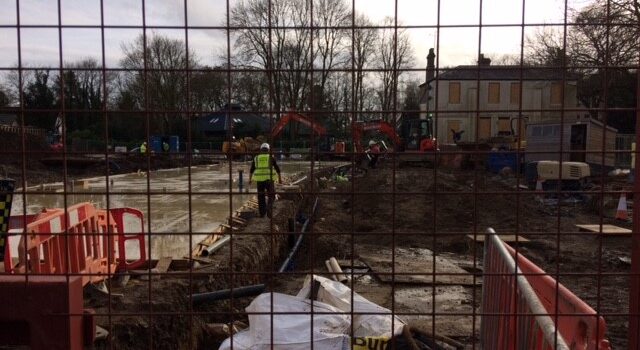The find of the Century?
Local archaeology has been much in the news of late in our region; the Sutton Hoo excavation in Suffolk of 1939 formed the basis of the recent Netflix film, The Dig, and King’s College has reported that an early medieval graveyard (c400-650 CE) has been discovered on the Croft Gardens site in Barton Road. This latter discovery has been described as “one of the most exciting finds of Anglo-Saxon archaeology since the 19th century” but one wonders how it can be compared with the “British Tutankhamun” of the 1,300 year old burial ship and its spectacular golden treasures that were revealed at Sutton Hoo. Certainly the graveyard is significant for Cambridge and our history.
At Croft Gardens, the team, employed by King’s, have discovered more than 60 well preserved graves and about 200 items of ‘grave goods’ including pottery, glass, bronze brooches, bead necklaces and swords. The graves were surrounded by Roman ditches which are significant given the site’s proximity to Roman Cambridge. The eighth century chronicle, written by the scholar Bede, suggested that the Romans left the area in the fifth century, but Dr Caroline Goodson, a King’s medieval specialist, speculates that from that time the Cambridge population became a mix of people of Roman descent and migrants from the continent. Volunteers at the Museum of Cambridge know well that both Northampton Street and Castle Street/Bridge Street were busy Roman roads and that the streets off Bridge Street are known as the ‘Danish Quarter’ – a reference to the Danes and Viking migrants that settled in the city.
This is not the first time that graves have been found in the Newnham area, for a small- scale archaeological excavation was undertaken by Access Cambridge Archaeology in collaboration with Newnham College in September 2010 with the aim of trying to find a number of skeletons excavated in 1939. The Newnham dig found evidence of significant Roman activity and post-medieval pottery and artefacts.
There have been other significant archaeological searches in the area, and I name but a few:
In 2018, three trenches were excavated at the nearby Ridley Hall. Archaeological finds were encountered in all three trenches from the early Neolithic through to mid-eighteenth century.
In June 2005, the Archaeological Field Unit of Cambridgeshire County Council conducted an archaeological evaluation within the area of a proposed development at Newnham Croft Primary School. A single feature was recorded; a shallow, undated ditch aligned northeast-southwest. Datable artefacts included a few very heavily abraded Romano-British pottery sherds and a larger quantity of 17th to 20th century material including clay pipes, pottery, nails, a gun flint and objects relating to the more recent land-use as school grounds.
The Sutton Hoo dig was carried out as WW2 was raging. For those of us at the Museum of Cambridge some pertinent social history finds were made during WW1. In 1914-16 a collection of fifty 17th century tobacco pipe bowls as well as fragments from Bellarmine jugs, a human skeleton, a prehistoric stone implement, two small tokens of tradesmen, one bearing the inscription “Thomas Cowell of Cambridge, his Half Peny, 1666”, the other showing the name “Edward Challis” plus a copper coin from the reign of George II were found in the site of Bredon House at Wolfson College. Around the same time the amateur archaeologist Hugh Scott moved into a house in Millington Road and found a very large number of clay pipes and some clay wig curlers in his garden topsoil.
The Museum of Cambridge Collection houses a large collection of clay pipes, some from the Newnham area, plus clay wig curlers and some Bellarmine jugs and some trade tokens. Future posts will look at these objects in detail.
Afterword:
It is my understanding that the Croft Garden’s find will be exhibited in the Museum of Anthropology and Archaeology in 2023. So we have some time to wait! Many examples from the clay pipe collection of the Museum of Cambridge are already on show, so please do come and have a look when the Museum is open again.
This post was written by Carolyn Ferguson, a volunteer at the Museum of Cambridge.
